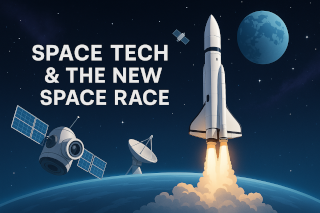Once upon a time, the Space Race was a Cold War rivalry between the U.S. and the Soviet Union. It gave us Sputnik, Apollo 11, and a generation of dreamers staring up at the stars. Fast forward to today, and we’re living through a new kind of space race—fueled not by politics alone, but by private innovation, commercial opportunity, and the looming question: What’s next for humanity beyond Earth?
🌌 The Rise of New Space Tech
Modern space technology has exploded in capability, while shrinking in cost and size. Here’s what’s pushing the frontier forward:
- Reusable Rockets: SpaceX’s Falcon 9 redefined the economics of space travel by landing (and relaunching) rockets. Blue Origin and Rocket Lab are following close behind.
- Satellite Miniaturization: CubeSats and smallsats now offer powerful capabilities in tiny packages—making space more accessible for universities, startups, and even individuals.
- AI in Orbit: Artificial intelligence is helping satellites process data on the fly, aiding in everything from disaster response to agricultural monitoring.
- Space-Based Internet: Projects like Starlink and Amazon’s Project Kuiper aim to connect the world with high-speed satellite broadband—especially remote and underserved areas.
🌍 Why the New Space Race Matters
Unlike the 20th-century version, today’s race isn’t just about national pride—it’s about survival, science, and serious business.
- Commercial Gold Rush: Space tourism, asteroid mining, satellite services, and lunar infrastructure could be trillion-dollar industries.
- Global Participation: Countries like India, China, the UAE, and Japan are landing on the Moon, sending probes to Mars, and launching their own astronauts.
- Climate Monitoring: Satellites play a critical role in tracking climate change, deforestation, and natural disasters—providing real-time data for global decision-making.
- Off-World Ambitions: NASA’s Artemis program and SpaceX’s Starship are laying the groundwork for long-term human presence on the Moon and Mars.
🛰️ The Players in the Game
Today’s space race is multi-dimensional—featuring governments, tech giants, and startup disruptors:
| Sector | Key Players | Focus Areas |
|---|---|---|
| Public Space Orgs | NASA, ESA, CNSA, ISRO, Roscosmos | Science missions, exploration, international policy |
| Private Giants | SpaceX, Blue Origin, Boeing, Lockheed | Rockets, satellites, lunar infrastructure |
| Startups | Rocket Lab, Planet Labs, Astrobotic | Small launches, Earth imaging, lunar delivery |
| Telecom Titans | Starlink, OneWeb, Amazon Kuiper | Global broadband and communications infrastructure |
🧠 What’s Next?
The next decade could bring some jaw-dropping breakthroughs:
- Permanent lunar bases
- Crewed missions to Mars
- On-orbit manufacturing and 3D printing
- Autonomous satellite swarms
- Space-based solar power
It’s not just science fiction anymore—it’s strategic planning.
🌠 Final Thoughts
We’re witnessing a new chapter in human history—one where space is no longer the domain of just a few governments, but a rapidly expanding ecosystem of innovation, ambition, and exploration. Whether you’re a tech enthusiast, entrepreneur, student, or just someone who loves to look up at the stars, now’s the time to pay attention.
Because the new space race? It’s already underway.

Leave a Reply